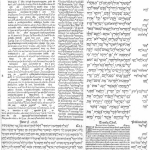Last book.
In the prior two books I’ve talked about, we saw that there exists a form of Islam that is very recognizable to Christians, and Westerners in general, in core beliefs of a merciful and just God, equality among all men and women, nonviolence, etc., but that this egalitarian Islam is not the norm, worldwide, and, according to our second author, is not at all mainstream but instead is only accepted by a minority of Muslims, in the world and in the U.S.
Some time ago, I wrote about the Jewish Enlightenment as a potential model for a new kind of Islam, one which interprets the Qur’an in light of these core principles. And I linked to an article in the Tribune explaining how local Muslim leaders were attempting to intervene before their kids consulted extremist “internet sheiks” for guidance:
AlQaisi said the mosque and school rolled out a campaign, urging youths to bring their questions to him or a dozen other scholars in the community instead of Google. Not only does that guarantee children will get authentic answers in an American context, it keeps the lines of communication open and preserves the “chain of narration,” the traditional transmission of Islam from person to person since the time of Prophet Muhammad, he said. . . .
At an assembly last week, Principal Omar Qureshi presented a verse of the Quran that begins with “And slay them wherever ye find them.” He showed the verses that come before and after the passage, explained that it referred only to military action and that only governments can declare war, not individuals.
“There’s a whole due process in our religion,” Qureshi said.
So what strikes me now in re-visiting this article is the difference between this explanation — of due process and “only governments can declare war” — and the explanation proffered by Ali-Karamali, that the so-called “sword verses” really only spoke of defense of the fledgling community under attack. Am I reading too much into this? I don’t know — hence, I’m reading another book, this one profiling Muslim communities by a sympathetic author. Do these Muslims believe in egalitarianism and justice first, and interpret the Qur’an in that light, or do they follow the beliefs handed down to them by their fathers and grandfathers, no matter what?
The author starts with a profile of Sheikh Hamza Yusef, a convert to Islam and one of its most public representatives, even having made a trip to the White House shortly after 9/11. (I’m not sure how he got the title of “sheikh” and google isn’t any help; from the context it seems to be interchangeable with imam.) She visits an instructional session in a hotel conference room, a weekend seminar of sorts, where he speaks to young adults, men and women — though the women (all with heads covered and wearing variants of abaya-like cloaks or shapeless skirts) sit off to the side, separated by a screen, and only receive an occasional glance from him. Though his lectures are about the theology and practice of Islam in general, there is talk of extremism — or, rather, resentment that Western reaction to extremists cause these nonviolent Muslims to feel persecuted.
What about Manji’s “spirit of ijtihad” from my prior book summary? Here’s what Abdo says:
Young Muslim Americans don’t want to practice their faith blindly; they want rational explanations for why behavior is acceptable or not. Almost alone among prominent sheikhs in America, Hamza Yusef meets this need. He relies heavily on his classical education to ground his rulings and advice about contemporary issues in Islam’s great intellectual tradition, often consulting the four established schools of Islamic jurisprudence called madhabs. He is determined to counter the new tendency among many Muslims to interpret the Koran for themselves in the absence of a legitimate imam. (p. 19)
What’s more, most of the imams in America are either immigrants, not able to counsel young Muslims on how to integrate and still remain to their faith or are not educated. Hence
They [Hamza and other like-minded scholars] interpret the texts by engaging in ijtihad, or independent reasoning. Ijtihad allows the imams to reinterpret the faith for modern times while adhering to Islam’s fundamental principles. (p. 21)
Is this Manji’s ijtihad? It doesn’t feel the same.
Abdo portrays these second-generation students as looking for reliable doctrine and educated teachers. At the same time, Hamza and his students take it as a given that head-covering, for women, and the long beard, for men, are important markers of piety, and, as least as far as headscarves go, a requirement except under exceptional circumstances, such as the post-9/11 period when women feared harassment. And as 9/11, and the concern for interfaith understanding, faded, Hamza began to “place Islamic violence in context,” that is, implying that it is justifiable. (p. 25)
(Incidentally, throughout the book, Abdo speaks approvingly of women choosing to cover, as either a requirement in Islam or at a minimum a sign of devotion to the faith and something to be celebrated and praised. She also regards the increasing move to veiling/head-covering in Egypt not as a negative sign but a positive development, as a sign of a religious revival.)
Abdo next features Sheikh Muhammad Yacoubi, a Syrian guest lecturer. He is Abdo says, “more conservative (p. 27) — and how! He counsels early marriage, 5 hours of sleep, and more time spent on religious study, less on TV.
Next up: the Muslim community in Dearborn. Abdo starts with a fifteen-year-old, daughter of Yemeni immigrants, whose parents decided it was time for her to marry, and a man twice her age, at that, thought at least the marriage wasn’t consummated. She sought support from her friends and from the imam in vain, and eventually demanded a divorce — but then remarried, again at her parent’s behest, two years later, though at least to someone she thought more likeable. But this, too, turned out poorly — she had a child immediately, but her husband, a recent immigrant, was only able to get a minimum-wage job, and shortly afterwards married a second time, by returning to Yemen, so the girl divorced him — though only civilly, as the imam wouldn’t grant an Islamic divorce. She later found a man she wanted to marry, but as he was black, an immigrant from Ghana, the community rejected him, and the former child-bride finally left her community for good.
The Yemeni community in the Dix Street neighborhood has assimilated into American culture slightly, if at all. Women are veiled, and at the mosque, they hear the imam only through a loudspeaker, wholly separated from the men in the basement. The imam is Saudi-trained and the mosque, Saudi-funded. All in all, “the Yemenis of Dix are more isolated than most Muslim enclaves in America.” (p. 48) — a significant change from the early history of the mosque, founded by Lebanese immigrants, who have now all left when the Yemenis came, with their stricter version of Islam.
[T]he Yemeni triumph at Dix foreshadowed the Islamic revival that was coming to Dearborn and the rest of the United States. In the years that followed, the conservative takeover of mosques became more widespread, as Muslims became more involved in their faith and increasingly influenced by Islamic practice in the broader Muslim world. (p. 55)
Abdo’s next profile is of Rami Nashashabi, a doctoral student at the University of Chicago whose father is a Palestinian, and a Jordanian diplomat and whose mother is (I think; Abdo’s unclear) an American, but he did not grow up in the United States. In Chicago, though, for the past decade, he has worked with an outreach organization to both help inner-city black kids and preach Islam to them, and attempt to build a multicultural Muslim society through the Intercity Muslim Action Network, IMAN.
And then — who should appear in a chapter on Muslims building their public image but our friend Irshad Manji?
Here’s what Abdo has to say about her:
Irshad Manji, the author of The Trouble with Islam, is one of the most damaging voice for the Islamic community. Of all the professional Muslims to emerge after September 11, Manji won most attention from the non-Muslim world. Her book was an international bestseller; she became a television pundit, and an essayist on the editorial pages of the world’s most influential newspapers. She earns thousands of dollars for speaking engagements on college campuses.
Muslims, as well as non-Muslim expert, around the world — particularly in Canada, Manji’s home and where she hosted a radio talk show — condemn her. First, most don’t consider her a Muslim, even though she was born as such. She identifies herself as a lesbian, and homosexuality is considered a violation of the faith. Her political views are the antithesis of Muslim feeling about nearly everything, from her favorable attitudes toward Israel in its conflict with the Palestinians to her support of U.S. policy in the Arab and Islamic world. A scholar of Islamic studies who is a friend of mine calls her a Muslim Zionist, a label Manji would no doubt accept. my own encounter with Manji was not encouraging; her opinions about Islam, she offered when I interviewed her in 2004 for the Tribune, had no basis in the teachings of the faith. As a result of her unorthodox views, many Muslims believe she claims to be a Muslim only to sell books; a Muslim denouncing the faith is a marketer’s dream.
To many non-Muslims, however, she is the voice of “progressive” Islam. Why progressive? Because Manji’s prescription for correcting the “troubles with Islam” is for the faith to conform to the ideas of Western philosophy. Essentially Islam would cease to be Islam.
What’s the bottom line? It’s hard to draw firm conclusions about what the Muslims that Abdo approvingly profiles believe, given that her focus is on their perception of persecution and their desires to practice their religion faithfully rather than give way to secularism. She becomes more strident throughout the course of the book, and, in the conclusion, rejects calls for a “reformation,” and perceives Islam as under “attack by the Western world” — listing as signs of this attack “September 11, the invasion of Afghanistan, the occupation of Iraq, the French government’s ban on headscarves, and even the decision of some European news organizations to publish the insulting cartoons of the Prophet Muhamad” (p. 200).
But it’s clear that they reject Manji’s description of Islam, and it would seem they reject Ali-Karamali’s approach as well. After all, she states multiple times that she feels confident that her faith allows her to let her conscience be her guide if something that Islam has traditionally commanded, appears to be unjust. The new generation of imams might take greater care to explain doctrine, but that doctrine hasn’t changed.
So that’s it for reading. Up next: putting this all together.












